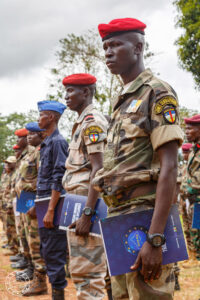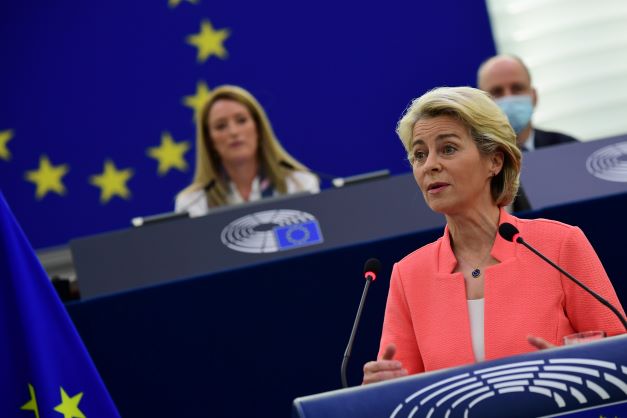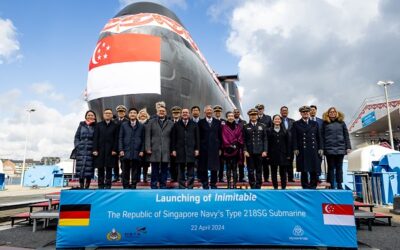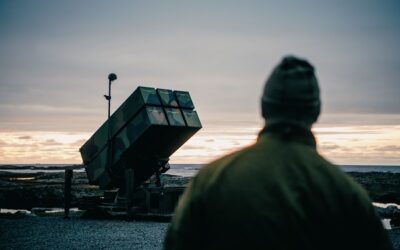Strategic Autonomy Lite?
[The questions as to how the EU’s Strategic Compass is evolving – and particularly, what is happening with regard to the Union’s potential rapid deployment capability – are among the most important issues in Europe currently. Having interviewed EU Military Committee Chair, Gen Claudio Graziano, in MilTech 6/2021, published this month, Mönch NATO and EU Affairs Correspondent, Caterina Tani, here expands on the issue in a report that will be published in MilTech 1/2022. – Editor]
The relationship between the United States and Europe has evolved over time. From the Cold War years, when Washington was almost in tutoring mode, it has evolved into a strengthened friendship, especially since 9/11 and the Global War on Terror. More recently, China’s irruption onto the political scene has driven Washington towards an Asia-Pacific focus and a consequent dilution of interest in Europe’s destiny. Brussels, in turn, aware that the Indo-Pacific figures foremost in American strategy, now feels obliged to grow up. But is it ready to fully manage its own interests and crises and, ultimately, to build an effective, credible defence?
Goodbye Europe
America – formerly ‘Global Cop’ – now has a double need: healing internal economic and social wounds; and trying hard to preserve its hegemonic role in a much more competitive world, characterised by the impressive and threatening rise of China. The two giants struggle for global domination – geopolitical, commercial, technological and military – focused around Taiwan and in the South China Sea. The competition is a real game-changer, even in Europe. The US has tried to re-direct NATO’s strategic interests to the Pacific but, unfortunately, there is no ‘P’ in NATO and Europeans – with more immediate, closer issues, and with huge commercial interests with China, responded rather evasively. Washington later returned the favour, withdrawing from Afghanistan without alerting Europeans, thereby confirming its downgrading of Brussels’ importance. The effect was very painful for Europeans, as was the announcement of AUKUS and the related ‘submarine affair’ – particularly for France, the most Indo-Pacific European power, which saw it as a betrayal and a humiliating lack of consideration.
Afghanistan also triggered the brutal recognition that Europe was unable to “send 6,000 soldiers around the Kabul airport to secure the area,” as High Representative Joseph Borrell noted. It emphasised the need to create some kind of EU rapid reaction force in order to face similar situations in an appropriate way.
These wake-up calls pushed the EU to reflect on Europe’s near-pathological dependence on the United States and (re)think its capabilities to manage crises, certainly not lacking in the continent’s wider surroundings – the Balkans, the Middle East, North and sub-Saharan Africa – amid turmoil, migration issues, and Russian-Chinese-Turkish-terrorist infiltrations.

The European Union Training Mission in the Central Africam Republic. (Photo: EEAS)
Brussels recognised it had to take on geopolitical and strategic responsibility, including the use of force where needed. It can no longer behave like a meek sheep in a world of wolves. It also recognized the need to avoid complete US disengagement and a potential withdrawal of the nuclear umbrella and support for missions in Europe’s interests, such as those in the Sahel. The situation motivated Europeans’ desire to be regarded as reliable, proactive partners, able to control their own courtyard. As Michael Gahler, a German MEP, commented, “We must be perceived as attractive allies, as appealing partners, [who are] able to do something on our own, not as helpless allies and partners [who leave the US to] do the whole job.”
Obstacles
Over time, European defence has been hampered by multiple factors. First and foremost, the political will of member states, ranging from France’s radical vision of strategic EU autonomy to the positions of the Baltics and Poland, spasmodically attached to NATO’s umbilical cord, with Germans and Italians in the middle. Other obstacles were divergence in state interests, the unanimous nature of the voting procedure and an atavistic reluctance to sully the Union’s ‘symbol-of-peace’ rubric by resorting to arms – a reluctance that has repeatedly translated into a sort of ‘mercantile neutrality,’ with Berlin its greatest exponent, as North Stream 2 and trade agreements with China demonstrate.
Another important barrier for Washington was the exclusion of its military-industrial complex from European defence initiatives such as PESCO – to which admission was eventually agreed. NATO, on the other hand, feared duplication of structures and a waste of resources.
A Non-Linear Process
The Afghan wake-up call jump-started the political will of the principal European states, and contributed to strengthening the determination of the Union itself, consequently activating a heated debate on the kind of force fit for purpose that could be drawn from EU and national political forces.
Commission President, Ursula Von Der Leyen, in her last State of the Union speech, called for a creation of joint forces able to be “provide stability in our neighborhood,” also proposing a summit on EU defence next year under France’s Presidency, and announcing a future EU-NATO declaration.
Pleas for a European defence mechanism came from Italian state and government leaders Sergio Mattarella and Mario Draghi, the latter a long-standing close ally of the US. President Macron, once a champion of “strategic autonomy,” got “essential clarifications” from Biden at the G20 over European defence and sovereignty, sought to “strengthen coordination [and] strategic collaboration between the European Union and NATO,” after French Defence Minister Florence Parly, at the last NATO Ministerial, had urged skeptics “don’t be afraid,” stating that European defence is not being built in opposition to NATO, but to strengthen it. In Germany, SPD candidate (now Chancellor) Olaf Scholz, kept an open position while his party published a plan to create a 28th European army, responsible directly to the European Commission. Simultaneously, Germany faces the end of Merkelism, which could not only influence European defence, but also recast the balance of continental power.
Meanwhile, the United States gave a green light to European defence and reaffirmed the importance of NATO. Secretary of State Anthony Blinken, then Secretary of Defence Lloyd Austin, both spoke in favour of EU defence, seeking “initiatives that are complementary to the types of things that NATO is doing.” Finally, at the G20, Joe Biden himself reaffirmed the strength of the transatlantic link and the usefulness of “developing a European defense also with regard to transatlantic security, in full complementarity.”
NATO asked the EU to cooperate more closely, in view of the forthcoming EU-NATO joint declaration of mutual cooperation, including in the areas of military, cyber and maritime security and climate change challenges.
An embryonic European force is finally being created. On 21 October Germany, Finland, the Netherlands, Portugal and Slovenia advanced idea building on the EU’s battlegroups, a force of 1,500 troops created in 2007 but never deployed. The proposal aimed to expand the troops from 1,500 to 5,000, to establish a bloc-wide joint military intervention force to deal with future military crises, plus space and cyber capabilities, together with air transport and special forces. A draft of the Strategic Compass circulated in November, designated the EU Rapid Deployment Capacity, positing it should allow rapid deployment of a modular force – including land, air and maritime components – by 2025, able to react to crisis situations, such as evacuation, rescue or stabilization missions. It will be “a coalition of the willing,” according to article 44 of the EU Treaty, in order to be more flexible regarding unanimity rules.
Battlegroups, Embryo of European Defence and an EU Army
The system of battlegroups has never been used, due both to a reluctance to deploy and to disputes over funding. It is clear, moreover, that a force of 1500 would have been insufficient. Although a step forward, 5,000 men too remains rather too limited a force. Considering the threats to which the EU is exposed, “the idea of moving from two to three battlegroups would be absolutely useless […] as there are very few crises that can be solved in this way,” Professor Sven Biscop, Director of the Europe in the World Programme at the Egmont Royal Institute for International Relations in Brussels, told MilTech. As, in most crises, “to do something meaningful [there should be] at least a brigade on the ground,” it would be a good idea to create a “pool of brigades – which means an army corps, in line with the original level of ambition of [the] CSPD, of up to 15 brigades, with 50 to 60.000 troops, deployable within 30-60 days, sustainable for a year […] and able to deal with more than one crisis at the same time.”

A Belgian soldier exercising with the EU Battlegroup in Germany, 2014. (Photo: Wikipedia)
Another problem with the new structure is it might end up having a sufficiently European character, but a purely intergovernmental structure, lying outside the EU Treaties. Although this does not necessarily affect operational considerations, it could certainly have repercussions. To improve the ‘EU characterisation’ of the force, Gahler suggested it would be a good idea to put “everything that is the non-military operational part – for instance, the administrative or non-military operational costs – under the administrative costs of PESCO,” – which lie, instead, within the EU budget. To go even further, the “intervention force should have a combination of PESCO elements (inside the budget) and the European Peace Facility (the member states’ off-budget fund for missions).” Notwithstanding the composition of the ‘coalition of the willing,’ “all 27 member states could [thus] profit from the missions politically and at the same time adding their financial contribution to the European Peace Facility.”
Realistically the prospect for an EU army is quite remote, in both short and medium terms. However, according to Professor Biscop, “A very nice symbol of political unity [might be that of] building up one entirely new EU brigade within the pool, where people are recruited from member states, as it happens for the Légion étrangére.” Another consideration might be the (future) role of the UK in such a force – which currently only involves EU member states. Indeed, the United Kingdom could be more important to Europe in facing Russia than following Washington’s sinophobic crusade in the Pacific.
Conclusions
The proposal to create a rapid intervention force is at an early stage, still under discussion. Certainly, it is not an Army Group: but it is an increasingly realistic and effective starting point. With the publication of the Strategic Compass, other instruments aimed at enhancing resilience, cyber deterrence and tackling hybrid treats are set to emerge. If correctly designed and implemented, the Rapid EU deployment capacity – along with the other instruments – might have a fundamental value to satisfy Europe’s needs and even to to set a precedent on which to nourish further ambitions. A lot will depend on how the troops will be trained, motivated, commanded, employed, and what they will achieve. If the system works properly, it can expand very quickly, as has happened several times in history. The gestation period will be influential, as well as the evolution of the several crises currently multiplying around Europe. Also, the transatlantic relationship – within which emerging EU defence seems to be willing to place itself – could deteriorate due to unwanted changes in the electoral rounds in the countries concerned. For example, a renaissance of Trumpism could lead Europeans to accelerate building a European army, to pre-empt a possible downgrading of NATO by Washington. Similarly, the sovereignist governments in Europe could slow down the same process in favor of a re-nationalisation of European defence.
Wait and see, then.
Caterina Tani is MilTech’s NATO and EU Affairs Correspondent, reporting from Brussels

























